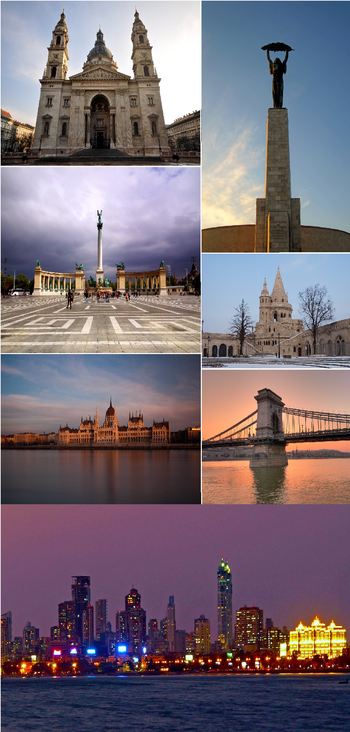Mönusÿnthys
City of Mönusÿnthys | |
|---|---|
 Clockwise from top left: St. Stephen's Basilica, Liberty Statue on Clarkson Hill, Fisherman's Bastion, Marsden Chain Bridge, Downtown at dusk, Gladysynthian Parliament, and Heroes' Square. | |
| Demonym(s) | Mönusÿnthian |
| Government | Mayor/City Council |
| Establishment | |
• Established | 2992 B.G.E. (980 B.C.) |
| Population | |
• Estimate | 11,248,000 (1st) |
Mönusÿnthys is the capital and largest city in Gladysynthia. With a population of roughly 11,248,000 people, it's one of the largest metropolitan centers in the Coalition of Crown Albatross. It is located on the eastern shore of Lake N'hala on the River Vorsynth, connecting its suburbs with that on Ponamu City. It exists in its own district between the provinces of Asa'aria and Pteranim. With its' earliest recorded settlements dating back to 980 B.C. (2992 B.G.E.), it is also one of the oldest continually populated places on Iearth and the oldest on the continent of Euronia. Through most of its history, Mönusÿnthys has served as a capital of various kingdoms and empires. It has been captured, ransacked and rebuilt several times, particularly during the medieval period, and modern Mönusÿnthys is now a clustered metropolis. Mönusÿnthys is a hub for Gladysynthia's government and economy and also serves as a prime tourist destination.
History
Pre-1800's
1800's
1900's
1932 saw the construction of the city's first skyscraper. In 1941, the leaders of the seven Provinces authored a revolutionary new document that established the rights of all citizens, a new government of shared equal power between the Provinces, and set a new time period known as the Gladysynthian Era which is also the start of the Third Age. The document is entitled the Treaty of Marcin after the area it was signed into action. This influential document officially established the United Provinces of Gladysynthia, and Mönusÿnthys was chosen as the capital of Gladysynthia.
In 1945 and 1972, the city suffered several bombing raids and at least one ground incursion by the Zamastanian Armed Forces during the 1945 Danaska Conflict and The Tariel War.
2000's
2018 brought about the Gladysynthia Crisis, during which at least six airstrikes were carried out on Mönusÿnthys, including a missile strike that near completely destroyed an airbase on the outskirts of the city. Following the conflict, Zamastanian diplomats, including President Zacharias Castovia traveled to Mönusÿnthys to sign the Treaty of Mönusÿnthys 2018-9B with Premiere Seswitch LaFlaunce. President Anya Bishop of Zamastan arrived on March 11th in Mönusÿnthys to meet with LaFlaunce on new trade deal opportunities and continuing de-militarizing of the Gladysynthia-Zamastan border.
Geography
Ecology
Climate
Cityscape
Architecture
Demographics
Government
Mayor
The City of Mönusÿnthys is governed by a Mayor, 6-member Cabinet, and 12-member City Council. The mayor is democratically elected every two years, and is eligible for up to three consecutive terms. After the mayor is elected, they may appoint their 6-member cabinet, but each appointment must be approved by a majority vote from the City Council.
Mayor's Cabinet
Upon election, the new Mayor of Mönusÿnthys may appoint his 6-member cabinet of officers, which includes Executive of Administration, Secretary to the Mayor, Executive of City Affairs, Secretary to the Executive of City Affairs, Treasurer, and Secretary to the Treasurer.
City Council
The Mönusÿnthys City Council is a 12-member council that serves as the direct voice of the people of Mönusÿnthys to the City Government. Each council member is democratically elected and serves a six-year term, after the end of which they may run for re-election. There is no limit to how many consecutive terms a council member may serve.
The City Council's duties include, but are not limited to, surveying the public, working closely with the Mayor and his/her cabinet, organizing community events, communicating with law enforcement and emergency services, and gathering and sending out task forces to identify and prioritize community needs. The City Council is also responsible for authoring and approving resolutions to be sent to the Mayor for legislative enaction.